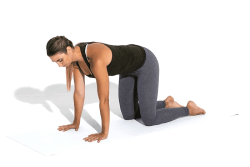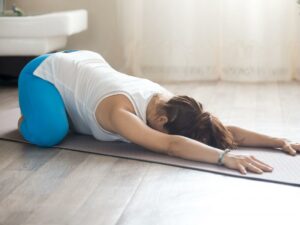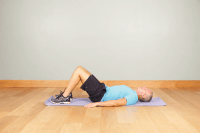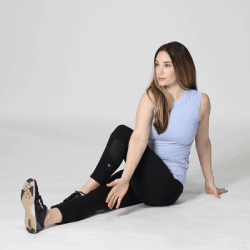Dealing with discomfort in the lower back is a common experience, but when coupled with bowel pressure, it can raise concerns and warrant a closer look at potential underlying causes. This blog explores the intricate relationship between bowel pressure and lower back pain, shedding light on possible explanations and offering insights into when to seek medical attention.
Contents
Can Bowel Pressure Cause Lower Back Pain?
Yes, bowel pressure can cause lower back pain and the connection between the two lies in the intricate network of nerves and muscles in our bodies. The lower back and the digestive system are close, and when issues arise in one area, they can affect the other. The nerves that serve the lower back also connect with the gastrointestinal tract, creating a complex interplay.
Digestive disorders, such as irritable bowel syndrome (IBS) or constipation, can lead to a sensation of bowel pressure. This pressure may then affect the nearby lower back muscles and nerves, contributing to discomfort. Similarly, musculoskeletal strain in the lower back can impact the digestive organs, leading to feelings of pressure in the bowels. The relationship between the two is dynamic, and issues in one area can influence the other.
Potential Causes Of Lower Back Pain Due To Bowel Pressure
The potential causes of lower back pain due to bowel pressure can vary and may involve a combination of factors. It’s important to note that only a healthcare professional can provide an accurate diagnosis. Here are some potential causes:
- Digestive Disorders: Conditions like irritable bowel syndrome (IBS), constipation, or inflammatory bowel diseases can lead to bowel pressure. The proximity of the digestive organs to the lower back can contribute to discomfort in this area.
- Pelvic Floor Dysfunction: Dysfunction in the pelvic floor muscles, often related to childbirth or muscle imbalances, can result in both bowel pressure and lower back pain.
- Musculoskeletal Strain: Strain in the muscles of the lower back, either due to poor posture, overuse, or injury, can contribute to discomfort. This strain may also affect nearby organs, including the bowels.
- Nerve Compression: Conditions like a herniated disc or spinal stenosis can lead to compression of nerves in the lower back. This compression can affect both the lower back and the functioning of nearby organs, such as the bowels.
- Postural Issues: Poor posture, whether sitting or standing, can contribute to lower back pain. Over time, incorrect posture can lead to muscle imbalances and strain in the lower back region.
- Psychosocial Factors: Emotional stress, anxiety, or depression can contribute to physical symptoms, including lower back pain. The mind-body connection plays a significant role in overall well-being.
- Dehydration and Lack of Fiber: Inadequate hydration and a lack of dietary fiber can lead to constipation, causing increased pressure in the bowels and potentially contributing to lower back discomfort.
- Visceral Sensitivity: Some individuals may have heightened visceral sensitivity, where the organs in the abdominal and pelvic regions are more sensitive to stimuli. This sensitivity can contribute to both bowel pressure and lower back pain.
Treatment Options For Lower Back Pain Due To Bowel Pressure
The treatment options for lower back pain due to bowel pressure aim to address the underlying causes and alleviate symptoms. It’s important to consult with a healthcare professional for personalized advice based on the specific diagnosis. Here are common treatment approaches:
- Addressing Digestive Issues: If the lower back pain is a result of digestive disorders like irritable bowel syndrome (IBS) or constipation, management of these conditions is crucial. Dietary changes, increased fiber intake, and medications prescribed by a gastroenterologist can help regulate bowel movements and reduce pressure.
- Pelvic Floor Physical Therapy: For cases involving pelvic floor dysfunction, pelvic floor physical therapy may be recommended. Therapists can work with individuals to strengthen or relax specific muscles, promoting better coordination and function.
- Pain Management Techniques: Over-the-counter pain relievers, such as nonsteroidal anti-inflammatory drugs (NSAIDs), can help manage lower back pain. However, it’s essential to use these medications under the guidance of a healthcare professional.
- Musculoskeletal Interventions: If musculoskeletal issues contribute to the discomfort, interventions such as physical therapy, chiropractic care, or massage therapy may be beneficial. These approaches aim to improve posture, reduce muscle tension, and enhance overall musculoskeletal function.
- Nerve Decompression Procedures: In cases where nerve compression, such as a herniated disc, is identified, medical interventions like epidural steroid injections or surgical procedures may be considered. These aim to alleviate pressure on the nerves contributing to lower back pain.
- Consultation with Specialists: Depending on the specific diagnosis, consultation with specialists such as gastroenterologists, orthopedic surgeons, or pain management physicians may be necessary. Collaborative care ensures a comprehensive approach to addressing both bowel pressure and lower back pain.
Exercises To Relieve Lower Back Pain Due To Bowel Pressure
Experiencing lower back pain due to bowel pressure can be challenging, but certain exercises may help alleviate discomfort and promote overall well-being. It’s essential to consult with a healthcare professional before starting any exercise program, especially if you have existing health conditions. Here are some exercises that may be beneficial:
Cat-Cow Stretch
- Start on your hands and knees in a tabletop position.
- Inhale, arch your back and lift your head and tailbone (Cat position).
- Exhale, round your spine, tuck your chin and draw your belly button toward your spine (Cow position).
- Repeat this gentle flowing motion for 10-15 repetitions.
Child’s Pose
- Kneel on the floor with your big toes touching and knees spread apart.
- Sit back on your heels and reach your arms forward, lowering your chest toward the floor.
- Hold this stretch for 20-30 seconds, focusing on breathing deeply.
Pelvic Tilts
- Lie on your back with your knees bent and feet flat on the floor.
- Tighten your abdominal muscles and tilt your pelvis upward, flattening your lower back against the floor.
- Hold for a few seconds, then release.
- Repeat this movement for 10-15 repetitions.
Bridge Exercise
- Lie on your back with knees bent and feet hip-width apart.
- Lift your hips toward the ceiling, engaging your glutes and lower back.
- Hold for a few seconds and lower back down.
- Perform 10-15 repetitions.
Child’s Pose with Side Reach
- Start in Child’s Pose as described earlier.
- Walk your hands to one side, feeling a gentle stretch along your side.
- Hold for 20-30 seconds, then switch to the other side.
Seated Spinal Twist
- Sit on the floor with your legs extended.
- Cross one leg over the other, placing the foot outside the opposite knee.
- Twist toward the bent knee, placing the opposite elbow on the outside of the bent knee.
- Hold for 20-30 seconds and switch sides.
Gentle Pelvic Floor Exercises
- Kegel exercises can help strengthen the pelvic floor. Squeeze the muscles you would use to stop the flow of urine, hold for a few seconds, and then release.
- Perform 10-15 repetitions throughout the day.
Conclusion
In conclusion, understanding the intricate relationship between bowel pressure and lower back pain is essential for those experiencing this discomfort. The potential causes range from digestive disorders and musculoskeletal strain to pelvic floor dysfunction and nerve compression. While lifestyle modifications, exercises, and self-care practices may provide relief, seeking professional medical guidance is crucial for an accurate diagnosis and tailored treatment plan.
If you’re experiencing Back pain, physical therapy for back pain at PhysioMantra can help: Book an online physical therapy session.










